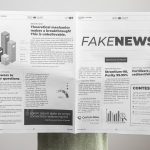The Criteria We Can Use to Evaluate Claims
We know that we are being bombarded with information and that it is important to try to discern fact from fiction and honesty from lies. We know that even well-meaning people can inadvertently introduce their own distortions and erroneous judgments into our information space. We need to be able to form a more accurate picture of reality that is as free as possible from outright falsehoods and half-truths and not-quite-truths and is as fact-based and detailed as possible.
How can we reasonably conclude that any of the information that is being thrown at us is true? This has to hinge on the evaluation of the evidence for and against any given claim. A person is epistemically justified to believe in a claim if they evaluate all available evidence and this leads them to reasonably conclude that it is in fact true. Put another way, if the one evaluating the claim can reasonably conclude that the events or states of affairs that the claim is about actually happened, then it makes sense to believe in it. At a more detailed level, we can say that if one reads or hears a claim being made by another person or a machine and they can reasonably conclude that the explanation for this is that the claimant was somehow caused to honestly communicate details of some event that they directly observed, then they are justified to believe that this claim is true. It might be that there was a chain of people and/or machines propagating some claim from one to another, but ultimately every true justified claim has to have started with someone or something who actually observed the phenomenon firsthand.
Evaluating claims is quite difficult, but there are guidelines that one can follow to make this process easier. There is always contextual information that comes with any claim and this can be used to help with evaluation. For any claim, one can take note of a few related factors and these should allow them to judge whether the claim makes sense and how accurate it seems to be, often in relation to existing knowledge. A claim probably has to meet all or most of the following conditions, which can be gathered by understanding details related to the content of the claim and the immediate source of the claim (ranked in order of importance):
- Observed firsthand by the original claimant: The claim was ultimately observed firsthand by the original claimant. This condition is met when the one evaluating the claim has a certain understanding of the process through which the original claimant came to believe in the idea behind this claim, and this process is plausible because it only involves the use of senses and mental facilities that the claimant is known to have. Any claim that comes from a person must come from an idea in someone’s mind, and this person needs to have evidence for this idea in order for a claim based on it to be epistemically justified. For example, if the source is an archaeologist and they are making a claim about the shape of prehistoric bones, then it is implied that the archaeologist came to believe the idea behind this claim from digging for bones and carefully observing them with the eyes and the hands and then coming to a reasonable conclusion. If this is the case then the archaeologist has evidence for the idea behind their claim and it is understood that this evidence came through senses that most of us have, namely seeing and feeling. If the one evaluating the archaeologist’s claim realizes this fact, then this condition is met for this claim. A contrary example would be if a religious priest makes a claim that involves something divine that he says he came to believe from a special sixth sense he has, but where this sense cannot be independently verified to exist. In this situation, the priest’s claim fails to meet this condition. To clarify, it is conceivable that a sixth sense could exist and for multiple people to agree that one can gain knowledge through such a sense. If a religious priest were to make a claim that supposedly came to him from a sixth sense that his congregants mostly believe exists because of their own experience of having this same sense, then these kinds of claims might be justified. We can extend this category to machines as well if we consider that many machines have ways of reading and measuring certain conditions in the natural world and storing this information and reporting on it. A machine would only be justified to report on conditions that it has the ability to actually measure. For example, a machine that is only capable of reading the temperature would not have any justification to be reporting on air pressure or wind speed. Another factor is that in all cases, including those involving people and machines, the claimant is only justified to report on something that they observed if they were present at that time and place.
- Naturalizable claim: The content of the claim can be understood as resulting from natural laws. This can actually include natural laws that are known to exist and also those that could be assumed to exist in order to naturalize the claim within one’s mind. This factor plays into evaluation because some claims postulate the existence of something supernatural, while others rely solely on natural events and causes. Natural events are those that causally occur with perfect uniformity based on pre-existing factors. The laws of nature are those that govern how things are caused to change through time. If things always happen with uniformity based on some set of laws, then this is “natural” by definition. This includes the modern updated versions of the law of gravity, Newton’s laws of motion, etc. A claim that can take the form of a natural law can be considered naturalizable. If a claim is made that cannot be conceived as the functioning of natural laws then this is considered either non-natural or supernatural. For example, a claim that says that water was turned into wine is supernatural, assuming that there is no natural law through which water can in certain special circumstances suddenly turn into wine. The only way that it can be reasonable to believe in a supernatural event is if it is personally experienced. Also, belief in supernatural events that are not personally experienced must largely rely on blind faith. It is important to understand that although the word “supernatural” has magical and mystical connotations, for the sake of philosophy this can be misleading. Although we are far more accustomed to observing natural occurrences, this does not necessarily mean that it is inconceivable that some supernatural event could occur. Such an event would plainly and simply be one that is not subject to the natural laws. There need not be anything otherworldly or paranormal going on. But while this is conceivable, it does seem highly unlikely and it does not make sense to believe in any such thing on the basis of secondhand information.
- Minimally propagated: The claim has been propagated a minimal number of times from the original claimant, who observed it firsthand. The one evaluating claims can receive some such claims reported directly by the one who supposedly observed it firsthand, but it is more often that claims are propagated through some sort of media before they get to the information consumer, who then has to figure out if the information is credible. We know that a lot of claims are not made by firsthand observers, but any true and justified claim must ultimately have started from a firsthand source. If a claim was propagated from the original source, then this decreases its credibility at least to some extent (all other factors being equal) because it is already secondhand information by the time it gets to the evaluator. If a claim was propagated multiple times by people who cannot personally verify the information from firsthand observation, then this further decreases the credibility. In most cases, the condition of minimal propagation is only met if a claim was propagated no more than once from its original source, which means that it would be the claimant’s firsthand information. For example, if a journalist interviews a witness to a murder and then reports on this, then this is the journalist’s secondhand information, but this claim can still be credible if the other conditions are met. If this journalists had personally witnessed the murder, then the report would be firsthand information, but most journalists are not in a position to personally witness all matters of public interest, and so we often have to make due with secondhand information, which can nonetheless be credible when each of the other conditions are met. We can compare this to a journalist who hears a rumor that has been circulating among many people in a community regarding who committed a murder, where none of the people interviewed actually witnessed the crime. In this case, the journalist could not have even been justified to believe these claims in the first place because these claims were no better than secondhand information. If the journalist were to report on this then it would be thirdhand information and thus would not be credible from the audience’s point of view, even if other conditions are met.
- Coherent claim: The content of the claim is coherent with all of one’s existing knowledge, which must ultimately be coherent with personally observed facts about how nature works. What this means is that if a claim directly contradicts some clearly known fact then this new claim fails to meet this condition. This would be the case whether the existing knowledge came from direct personal observation or from another claim, although personal observation is stronger. But there is a scenario in which it makes sense to accept a claim that contradicts existing beliefs, which happens when that which was previously assumed to be true also came from a claim rather than a personal observation and the new claim meets every other condition in this criteria to an equal or greater degree than the older claim. In situations such as this, the new claim can be accepted in place of the old one, which can then be assumed false. For example, we can imagine a murder trial in which the man accused has confessed to the crime, and he says that he acted alone in this crime and that he shot the victim and that nobody saw it. Since this confession meets all of the other criteria for evaluating claims, we can be justified to believe that he is the murderer. But then video footage is found that clearly shows someone else committing the murder and the first person is not shown in the video at all. We can consider this video to essentially be another claim that contradicts the first man’s confession. Since the video is more credible than a verbal confession, we have to accept it as true and consider the first man’s confession to be false.
- Credible claimant: The sources of the claim, including the original source who supposedly observed it firsthand and all media that propagated it, have earned credibility in the subject area that the claim relates to because they have a good track records. The credibility of a claim is stronger or weaker based on the track record of any source that provided or helped propagate the claim, all other factors being equal. The credibility of a claim is stronger if it comes from a source that has a history of providing accurate information and of not providing disinformation, which is a claim shown to be false due to the prevalence of counterevidence. Conversely, if a claim comes from a source that does not have a history of providing accurate claims and instead has a history of providing disinformation, then the credibility of this claim is weaker. For example, we can hypothetically say that the claimant is a meteorologist who has in the past made accurate weather predictions. If this person were to make a prediction for tomorrow’s weather then this claim is highly credible. Also, if there is an information source, perhaps even one that purports to be “news”, that has a history of propagating false information a large percent of the time, where one can even debunk some of the claims that this source propagated on the basis of personal observation, then the information coming from this source can automatically be considered highly suspect. On the other hand, news sources that propagate information that can be verified as mostly accurate a very large percent of the time would have to be considered credible sources, even though it is still possible that any information that they report could later prove to be inaccurate. It is the overall percent of the propagated claims that are accurate versus those that are false that determines the credibility of an information source.
- Credentialed claimant: The source of the claim is trusted by other sources that also have good track records in the subject area that the claim relates to. A good way to identify this is through official credentials or membership in a professional organization that has its own credibility. For example, if a self-proclaimed meteorologist makes a claim about the weather, but this person is not trusted by other meteorologists who have good track records, or is lacking in professional credentials, then the claims made by this untrusted meteorologist fails to meet this condition. This condition is often met by people and organizations who have professional credentials such as higher education degrees or certifications or membership in professional organizations. It can also be met when people or organizations have a reputation of trustworthiness among their peers, even if they lack official credentials.
These categories are all qualitatively different factors that one can take into account when evaluating a claim. These criteria points represent how one can classify the relevant evidence that might or might not exist in relation to the claim being evaluated. Any evidence, aside from direct personal observation, would probably fall into one or more of these categories. Though it is always conceivable for any claim to be true or false, if a claim meets all of these conditions then it is quite unlikely for this claim to be completely false, and thus we can say that a claim meeting all of these conditions is epistemically justified. Of course, even if all of these conditions are met, there is always more evidence that one could gather, but any such evidence would have to fall into one of these categories. In some cases, a claim can be justified without meeting all of these conditions. Whether indeed one is epistemically justified to believe in a claim ultimately hinges on whether the overall evidence is sufficient to be conclusive. This evaluation relies on a complex interplay of deductive and inductive reasoning and it is extremely difficult to pin down exactly what are the necessary conditions for this to be conclusive. Even though inductive reasoning will always be fallible, there is nonetheless a difference (in many cases) between the most reasonable conjecture one can come to given certain evidence and having sufficient evidence to come to a reasonable conclusion.
Photo by Miguel Henriques on Unsplash









